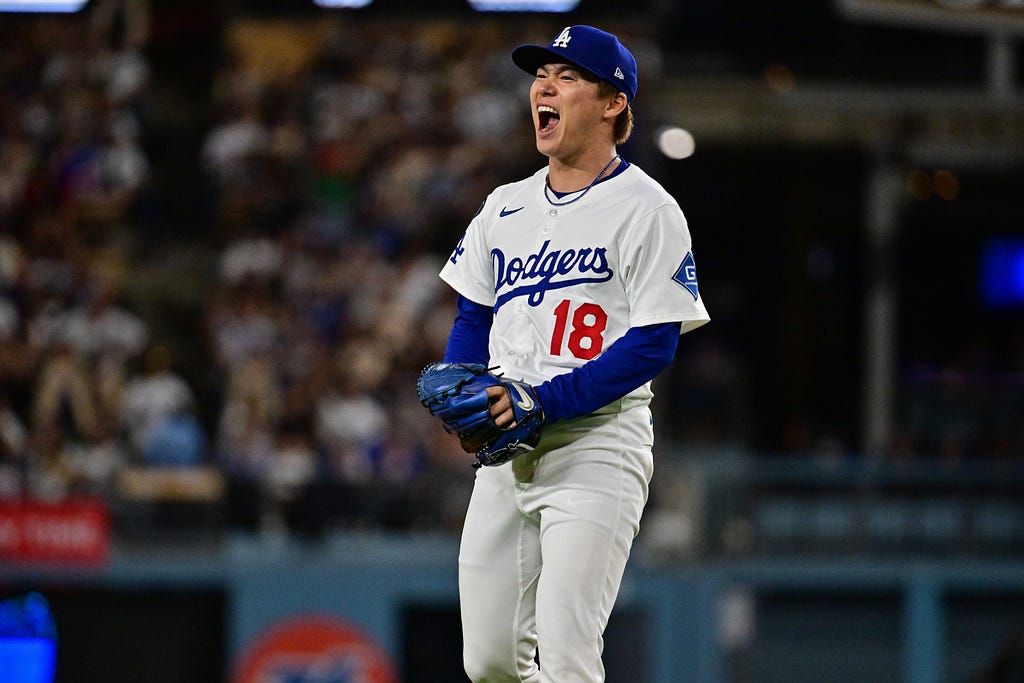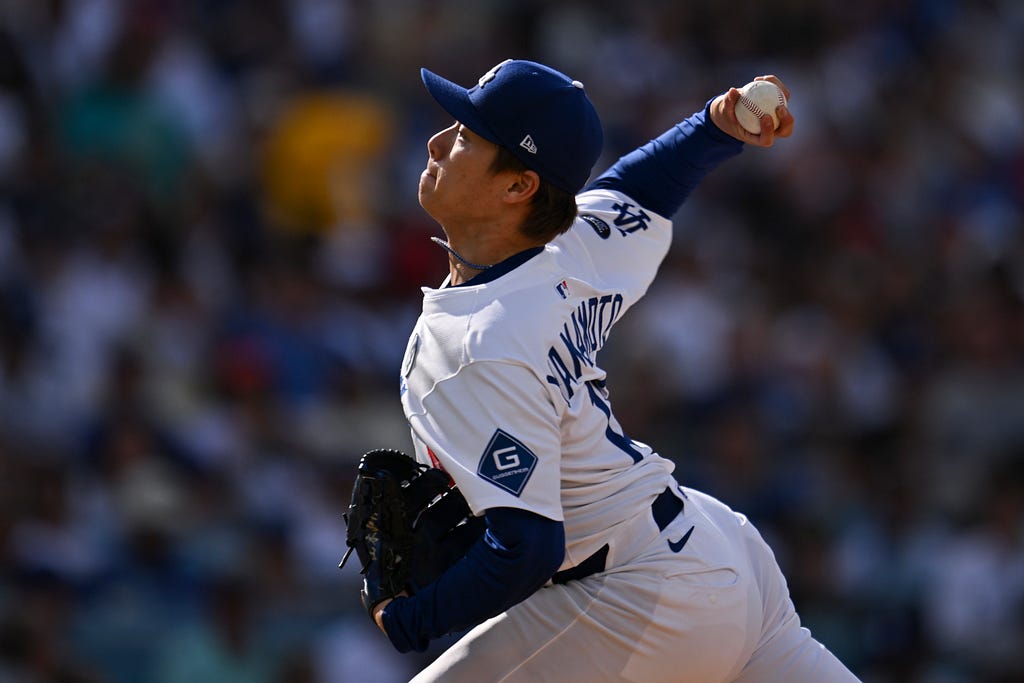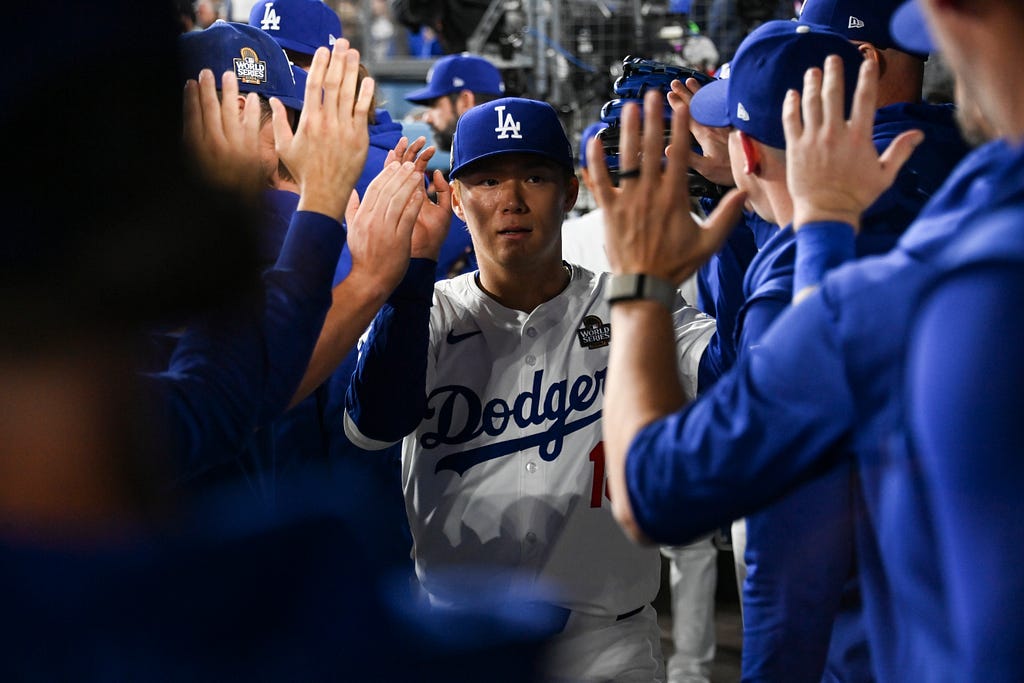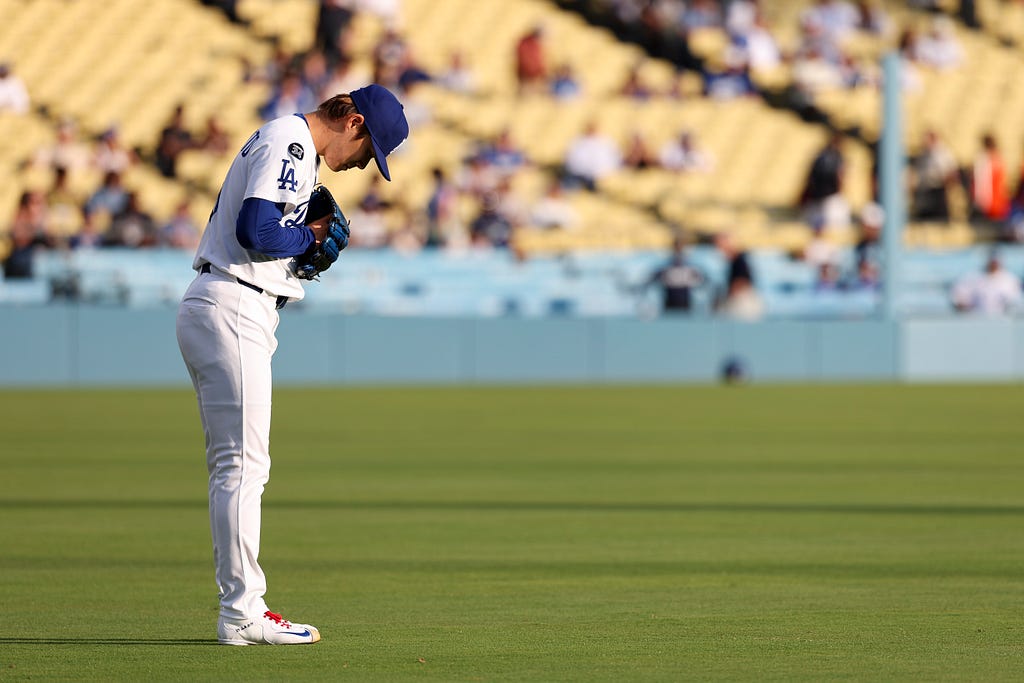From Dodger Insider magazine: Yoshinobu Yamamoto — Adaptation
Yoshinobu Yamamoto has found his comfort zone with the Los Angeles Dodgers

by Cary Osborne
There was something about Yoshinobu Yamamoto’s body language that exuded confidence.
Was it the eyes? Laser-focused on a target.
Or the shoulders? Firm and squared.
Or maybe it was the repetitive action of a body perfectly in sync from head to toe as a right arm fired a baseball into a glove 60 feet, 6 inches away.
There was an aura back in February when Yamamoto stood atop the hill at Camelback Ranch in the first days of Spring Training.
The aura has remained consistent throughout Yamamoto’s second Major League season. He was the ace of aces in Japan — a 2020 Olympic gold medalist and All-Olympic Team selection and the three-time Eiji Sawamura Award winner and Pacific League Most Valuable Player in the Nippon Professional Baseball league.
In the first half of 2025, Yamamoto was talked up as an early Cy Young Award contender and at times a dominant pitcher ascending toward ace status in the Major Leagues.
After a year of navigating a completely new group of professional baseball hitters, as well as the challenges of culture, routine and travel, all signs point to a pitcher who has found comfort.
“He’s super confident — a super confident guy,” says catcher Will Smith. “He seemed pretty confident to me last year once he got settled in. He had a really good year last year. But he probably went into the offseason feeling good. Winning the World Series — that helps. He came back in the spring and probably felt good.”
But there’s the admission that he was finding his way.
“Last year, I really didn’t know anything — how the season works (the flow of the season), how to communicate with my teammates or coaches, nothing,” Yamamoto says. “But I’ve gotten more used to things, built good relationships, and now I can actually communicate well. I’ve also gotten used to various aspects of my life off the field as well. So things feel a lot more stable. Little by little, and I feel like I’m finally starting to play my game.”
It was a matter of time.

To Dodgers Vice President of Player Personnel Galen Carr’s recollection, the Dodgers really began bearing down on scouting Yamamoto three years before he decided to make the move from the NPB to the Major Leagues. That timeline would put it right as Yamamoto was establishing himself as the top pitcher in Japan.
Carr, who oversees international scouting for the Dodgers, worked for the Boston Red Sox for 15 years starting in 1999. He begins to make a comparison to 5-foot-11-inch, 170-pound Pedro Martinez because of the likeness to Yamamoto’s frame — 5–10 and 175 pounds. Martinez pitched for the Red Sox from 1998–2004 during his Hall of Fame career.
Each pitcher does not have the prototypical starting pitcher’s body. Yamamoto is one of four starting pitchers, 5–10 or shorter and weighing 175 pounds or less, with double-digit starts over the last two seasons.
Yamamoto’s and Martinez’s success show that one can’t judge a book by its cover. Carr and the Dodgers didn’t when they saw Yamamoto pitch for the first time.
“You’re looking at a sort of undersized body without a lot of evident mass or strength or leverage,” Carr recalls. “And what comes out of his hand is just remarkable — the quality of raw stuff, the ability and athleticism to repeat and execute location, his command and his conviction and level-headedness on the mound was instantly apparent.”
Not that the level-headedness wasn’t there last season.
His Major League debut in Korea was a stunner — one inning, five runs allowed to the Padres on March 21, 2024.
What followed was five shutout innings in his first start in the United States; a breakthrough performance at Yankee Stadium on June 7, 2024; five shutout innings in Game 5 of the National League Division Series against the Padres; and a shutdown of the Yankees in Game 2 of the World Series.
“Around the start of the postseason, I really found my rhythm and was able to throw better and better,” Yamamoto says. “That gave me a lot of confidence. Things started to click, and I began to get a clearer sense of what I needed to do. That was the biggest thing for me.”

It was evident when he stood on a mound in mid-February at the Dodgers’ Spring Training facility. A crowd had gathered behind a fence to observe Roki Sasaki, the team’s latest Japanese acquisition, pitch for one of the first times in a Dodger uniform as Yamamoto threw behind him a few rubbers on the long stretch of a dirt mound.
“You could feel it during Spring Training. It was evident,” Carr says. “Emanating the confidence and the conviction — it was just there. I think getting to know (Yamamoto) before in the posting process, it was evident to all of us that he has a lot of confidence in himself, a lot of conviction in his own abilities. But he wasn’t cocky at all. So I think the combination of his curiosity — because he asks really good questions — thoughtfulness, confidence, conviction, and really his willingness and discipline to work that combination of those four or five things is what makes him who he is. But it was no doubt, there was something different about his energy this spring, 100% — and it obviously persisted.”
Through his first seven starts this season, confidence, command and stuff helped combine to make him the best pitcher in the Major Leagues through the first week of May. That stretch was capped off with a start in Atlanta on May 2, when he took a no-hitter into the sixth inning. He left that game after six scoreless innings and a season ERA of 0.90.
Three starts later, he took a no-hitter into the seventh inning against Arizona at Dodger Stadium on May 20. But in the seventh, he found trouble after losing his bid for history. Runners were on the corners with two outs and the Dodgers hanging onto a 1–0 lead.
Yamamoto rarely shows fatigue. In workouts, he utilizes a small breathing tube, kind of like a straw, that restricts his breathing. There are a few benefits — it readies him for the tension of a game and also increases his endurance.
Dodger officials, coaches and players have marveled at his fitness, flexibility and mobility. It’s contortionist-like. All of this was on display in the moment.
“It’s the ability to be mobile and nimble on the mound,” says pitching coach Mark Prior. “He’s able to stabilize in extreme positions — meaning extreme external rotation. But he’s also able to hold the energy where most guys lose those things. He’s able to maximize his frame probably more effectively and efficiently than somebody who’s 6-foot-5 at times. So that’s the advantage.”
That’s how on the 110th pitch of the night, Yamamoto remained calm under duress and delivered a cutter from a model delivery to the bottom of the zone. Arizona’s Pavin Smith foul tipped the ball into Smith’s glove for strike three.
“It’s really fun to catch him,” is how Smith describes working with Yamamoto.
It was at that point where the word “ace” was picking up steam. Yamamoto had pitched like one and was starting to build a resume in Major League Baseball in a short period of time reflective of an ace.

But there is rarely a straight line for even the best pitchers in baseball.
Thus, Yamamoto began to experience a few challenging times over his next seven starts. Though there were two starts when he didn’t allow a run, there were also two where he didn’t get through five innings. He allowed four runs to the Yankees on June 1 and five runs to the Giants on May 13.
But two things won’t change — first, others’ confidence in him.
“He’s got his days where he’s not commanding it like he normally does. It’s pretty hard to have that every single day,” Smith says. “(But) he’s super competitive, super focused on his work and his routine and taking care of his body and all that. He’s a pro.”
The other thing is his confidence in himself.
Yamamoto also recognizes that even with a World Series championship in his first season in the Major Leagues and some people touting him as an early pick to win a Cy Young Award, there’s much to prove. It helps drive him to establish himself as a Major League ace for years to come.
“There have been a lot of great moments, but also some frustrating ones,” Yamamoto says. “I want to use those experiences to keep growing and become an even better pitcher moving forward.”
From Dodger Insider magazine: Yoshinobu Yamamoto — Adaptation was originally published in Dodger Insider on Medium, where people are continuing the conversation by highlighting and responding to this story.